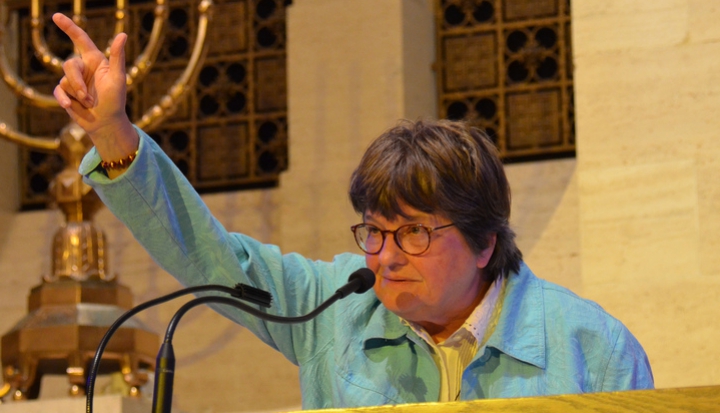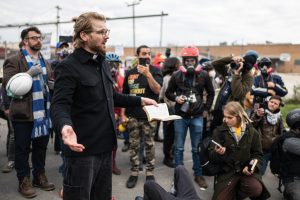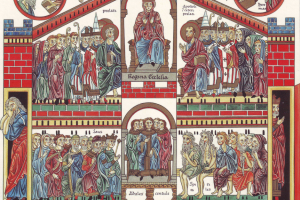In 1982, Sister Helen Prejean began a correspondence with two death row inmates in her home state of Louisiana. She eventually became the spiritual adviser to Patrick Sonnier and accompanied him to his execution in 1984. Prejean chronicled her experiences in Dead Man Walking, the best-selling book which has been adapted to a film (for which Susan Sarandon won an Oscar for her portrayal of Prejean), play, and opera.
It’s been 30 years since Sonnier was executed, and Prejean is now well known as one of the leading advocates for ending the death penalty. Our July 2014 feature examined how Catholics are working to end capital punishment in the United States, so we decided to sit down with Sister Helen and hear more from someone on the front lines about her experience working to overturn the death penalty.
What changes have you seen in your work to fight against the death penalty over the last few decades?
There have been significant shifts in the American people. We’re at 60 percent support of the death penalty. That’s the lowest level of support there’s been since 1972, right after the Supreme Court overturned the death penalty in the Furman decision. Support was at an all‑time low that had registered then at 57 percent.
A few things have happened. First of all, we’ve been working at it since 1976, when the court reinstated the death penalty. The American people are very practical at one level, and want to see what the cost is, and also the result. There’s an exorbitant cost to going after one felon with the ultimate penalty.
Two thirds of the American public don’t see the death penalty as a deterrent to committing crimes. Police chiefs don’t either. Twice, there’s been an opinion poll of police chiefs giving a list of 10 remedies to crime. They all put the death penalty dead last because they said when people do commit crimes, they don’t even think they’re going to get caught.
For the death penalty to be a deterrent means people are thinking of consequences, weighing them, and saying, “Maybe I’d better not do this because I might lose my life.” People see that’s not working at all. It has had no deterrent effect.
They can see the track record in the states where the death penalty is the most prevalent. The violence rate is not any significant less in Dallas, Texas than it is in Detroit, Michigan, where you don’t have the death penalty. You cannot see an appreciable difference in the decline and violence of crime.
Also, the American people have a sense of fairness. Glenn Ford was just released in Louisiana after 30 years. It was a mistake. They got the wrong person. In my second book, The Death of Innocents, I give the structural reason why it’s bound to happen that you’re going to have innocent along with the guilty, because 99 percent of people chosen for death are poor.
Why is that?
If you’re poor, you don’t have a crackerjack of defense to really resist prosecution when they’re going to go after the ultimate penalty, with pre‑trial motions and getting independent testing on evidence and all that. Going to trial is supposed to be an adversarial way of coming to truth. Prosecution presents. The defense presents.
Basically, the defense are often underpaid, overworked, and there’s a social stigma in the Deep South to lawyers who take death penalty cases. They’re identified with their clients. They don’t get invited to cocktail parties. It’s like, “What? You’re defending that scum?”
99 percent of people chosen for death are poor.
Now, we thought we had the best court system in the world with all of the appeals. We thought it would be a fluke to have an innocent person. Then DNA cracked it all open in the beginning of the `90s. DNA became the truth teller, saying, “You may have gone through 14 appeals courts. You may have had the Supreme Court even, but the fact is, you’ve got an innocent person.” DNA was the truth-teller to say, “Whatever you did, you didn’t do it right.” That opened the door in the beginning of the `90s. Now, we see with 144 wrongfully convicted people who have gotten off of death row.
The other thing about fairness that we’re seeing is what I consider the fundamental flaw in the guidelines the Supreme Court put in effect when they re‑instituted the death penalty in this country.
They gave a criteria that has become impossible to judge and makes the decisions as arbitrary as they ever were. The Supreme Court said that the death penalty is only to be reserved for the worst of the worst murders. Guess what? Nobody really knows what that means.
If you’ve killed my mother, I’ve lost the personal universe of my mother. That can never be replaced. Every killing of the human life is the worst of the worst, and so juries haven’t known what to do. What happens is, because the criteria is not workable, it’s not transparently clear. Culture takes over. Is it any surprise that 75 to 80 percent of all actual executions happen in the 10 Southern states that practiced slavery?
What effect has race continued to have on the death penalty in the United States?
In Reconstruction, after slavery, the fear factor for white people was huge. They had these black code books that you found in the Southern legislatures. A black man could steal an apple and be hung.
Remember, these are the same states that had all the extrajudicial lynchings to keep black people under. Because now that slavery is over, who’s going to work the plantations?
Is it any surprise that 75 to 80 percent of all actual executions happen in the 10 Southern states that practiced slavery?
Advertisement
What happened was, black people could be arrested for anything, loitering or whatever, then be sent to jail. Then they’re handed a huge bill before they can leave jail. They were being billed for being in the jail. They couldn’t pay it, so they sent them out to work. You had slavery, by another name, going on. It has continued now in the penal system with the death penalty and the whole prison system.
You go to our prison at Angola, in Louisiana. It’s 18,000 acres, made up of three former plantations, named after the slaves from Angola that used to work there. You see men going to the fields, hoes over their shoulders, walking out. There’s a guard on horseback, with a gun in the front and in the back, taking them out to the fields to work, 75 percent black. The average educational level is fifth grade. It’s the same.
What changes have you seen to Catholic involvement in fighting the death penalty?
When it comes to death, and the ultimate chasm between life and death, they say, “Anything less than death is like an affront, or dishonoring the victim, because the victim was killed, so that’s what we must do.” That’s how the death penalty is legitimized.
We come to our church in this. In 1984, when Pat Sonnier was executed, as I talk about in Dead Man Walking, I couldn’t get any help, in terms of raising consciousness, from the bishops of Louisiana, because we had Archbishop Philip M. Hannan telling his story. I loved the guy. He had been in the military. He had been a chaplain with paratroopers. He believed in the death penalty. He blocked the Louisiana bishops from saying anything, but it wasn’t just the bishops of Louisiana.
None of the bishops were out there. None of them were at the front, because a lot of times bishops get to be administrators. Who are they hanging with? They are hanging and going to lunch with the donors and the people who build the cathedrals.
When I had my dialogue with Pope John Paul II, what I said was, to the extent that the bishops and to the extent that any Christians are in touch with poor people, they get it about the death penalty.
To the extent that you’re really removed from the life of poor people, what happens? It becomes, “Well, we have to control the criminals.” Then there’s the fear element, “We have to protect ourselves against them.”
My invitation to the pope was to strengthen the Catholic teaching to be principled opposition to the state being able to take life, period. That was what that dialogue was about. I said, “If there’s any way you can help the bishops to stand up strongly, and to be active agents.”
Do you find that it’s still a hard sell to the pro‑life community in the Catholic Church that they should oppose the death penalty?
It is just beginning. Just remember how new it is. This is new. That was one of the things I said to Pope John Paul. I said, “Does the Catholic Church only uphold the dignity of innocent life?”
When I’m walking with a man to execution and he is shackled, hand and foot, he’s surrounded by six guards. He is going to be strapped down and killed, and he says to me, “‘Sister, please pray God holds up my legs.” Where is the dignity in this death? A totally defenseless person is being taken out and killed. Where is the dignity in this?
Pope John Paul got it. I was just part of the dialogue. Dialogue is always in the community of the people of God. Bubbles always rise up in the pot. When the pot boils, it’s never just one big fat bubble that comes up. It’s a lot of little bubbles that bob and then bubbles rise. It’s the way we evolve and change as a community.
Pope John Paul changed a part of the catechism and took away a criterion we had used for 1,600 years in the Catholic Church to determine who the state could execute. It was for “grave or grievous crimes.” You’re going to leave it up to governments to decide what they consider grave or grievous? You can never be entrusted with that life. You never have been entrusted with deciding who lives and who dies. We don’t give life. We can never be entrusted with taking life.
As the pope has mentioned, too, in Evangelium Vitae, the “Gospel of Life,” we have means of protecting ourselves from dangerous people in prisons. We should always choose bloodless means.
When John Paul II came to St. Louis in 1999, for the first time, we had a pope who put the death penalty in with the other pro‑life issues. He said no to abortion, no to euthanasia, no to physician‑assisted suicide, and no to the death penalty, which is cruel.
He recognized the torture in it. Our Supreme Court will not acknowledge the torture that is intrinsic to the experience of the death penalty, no matter what the method. A conscious, imaginative human being waiting in a room to be taken out and killed is mental torture. It is cruel and it is unnecessary because we have ways to defend ourselves.
In the end, it’s all there in St. Louis. Even those among us who have done a terrible crime have a dignity that must not be taken from them. That’s the first time it was said.
How do you teach it? How do you bring people on this journey? It’s always going to be that way. The bishops will make announcements and things. It’s up to us, the people, and that’s you and me sitting around this table. That’s what we do to make it real for people.
What can everyday people do to engage with the issue, to make it real?
First, and this is what we all need to do, is we have to descend into this issue and deal with it ourselves. Most of us have deeply ambivalent feelings about the death penalty because we are outraged over the deaths of innocent people. There is a part of every one of us that says, “These criminals who did this deserve to die.”
That is the personal conversion that we all have to undergo. That is the journey we all have to undertake. We do that by talking to other people. We do it by reading. You have to delve into the issue. There is going to be a personal journey of conversion that is involved in this issue because it is really a tough one. Catholics, we call ourselves pro‑life.
Pro-innocent life is one thing—unborn babies or people with Alzheimer’s—but guilty people, who have done these crimes and the consequences? We are believers in the law. If something is the law of the land, then we tend to say, “It’s good. This is God’s will, too.”
When you reach that point where you then grab the rope and begin to take action, where you begin to raise your voice in the public square, or you call the legislature and you realize you’re involved in helping the change come to your state, then that conversion process or that transformation has reached a point of taking action. All of that is a spiritual journey that has to precede it.
Action is a freeing thing. When we begin to act, we are freed up. Where we are paralyzed the most is where we stay inside our mind, “Maybe I could do this. Maybe I could do that. What about this? What about that?” We are caught inside our minds in all this. When we act, we get liberated. Action on behalf of justice liberates us, as well as who we are working for.
Why is it especially important to reach out to youth and have this generation involved in this issue?
As Tim Robbins has said, the young people are the bearers of the future, and they give us the most reason for hope. There was just a poll done not too long ago of millennials, and Christian millennials.
This showed that in the young people who identified themselves as Christian, only 32 percent agreed with this statement: “Government should have the option to execute the worst criminals.” That right of the state that for so long was part of Catholic teaching, 68 percent of Christian millennials now disagree with that.
Young people get it that gay people have dignity. It’s just from a lot more experience of real human beings. Everybody knows gay people and knows they’re good people. It’s happening about gay rights, and the dignity of people. It’s happening about the death penalty. It’s happening about human rights. It’s happening about a lot of things with the young people. Part of this is, in the Catholic community, we are teaching social justice more and more in the schools, and they’re getting it. They’re getting it.
When change happens, it happens through the people. Then gradually it filters up, or distills. I think we could show this on every social issue, the way slavery got abolished, women got the vote, and what’s bubbling up in the church right now about women, and what’s bubbling up in the church right now about birth control.
We have these distancing things in us. “Criminals, these people, the worst of the worst on death row. They’re not like us, so we have to kill them in order to keep ourselves safe as a society. We have to do the ultimate. It’s the only way you can show we’re really tough on crime.”
Now, with Pope Francis, the whole horizon has changed with what he’s encouraging us to do. Go out into the byways and encounter people. Not the judgment, “We got it, you don’t,” the censorship, but invite people in and encounter people. He’s washing everybody’s feet. This is the expression of Jesus. It’s just a human thing.
He’s bringing us back to the gospel of the byways, and the gospel of the encounter, and the personal encounter. He’s going to change everything, because what does it mean to love this person? What does it mean to see the dignity in this person and not to judge them?
If you could make sure that everyone in the country knew one thing about the death penalty, or if you could give everyone one question about it to wrestle with, what would you say?
To bring it to its essence of what it is, come there with me now.
Somebody’s done a terrible crime. We’re horrified with the crime. That’s a given. We’re going to say, “They’re guilty. They did it.”
Now come, and come with the guards, come and get that person from their cell. Walk with them, assist them, coerce them into walking across, and strapping them down, whether it be for the electric chair or lethal injection. Then all the guards leave the room who have played their part.
Think for a moment, if you were one of the guards whose job was that night that you had to help in the execution of a human being. It’s just your job. You’re not murdering anybody. It’s all legal.
Just for a moment, picture that you’re one of those people. Then all of those guards leave the room. Now, you’re the warden, and you’re the first trigger because you’re going to nod your head, or in Texas he takes off his glasses. There’s an unseen executioner behind that window who is now going to fatally inject, or pull the switch, to kill a human being.
You’re there, and you hear the person say their last words, whatever they are, and then you see. You’re present and it’s silent, and they kill the person. Then the doctor comes in, puts the penlight to see if the pupils are dilating or not, puts the stethoscope to the heart, has declared that the prisoner is dead.
They will then close the curtain, but what is happening is, they’re going to come in, and they have a body bag. They’re going to put the person in it and they’re going to take him out in an ambulance. Probably the photo op that they use the most is the ambulance coming out of the prison with the body of the person.
What have we done? What is the essence of that act that we have done to try to communicate to our children, and for our future that violence is not the answer to human problems. That’s the heart of the journey right there.
This is a web-only interview that accompanies “The beginning of the end of the death penalty” which appeared in the July 2014 issue of U.S. Catholic (Vol. 79, No. 7, pages 12-17).
Image: Flickr photo cc by Steve Rhodes













Add comment